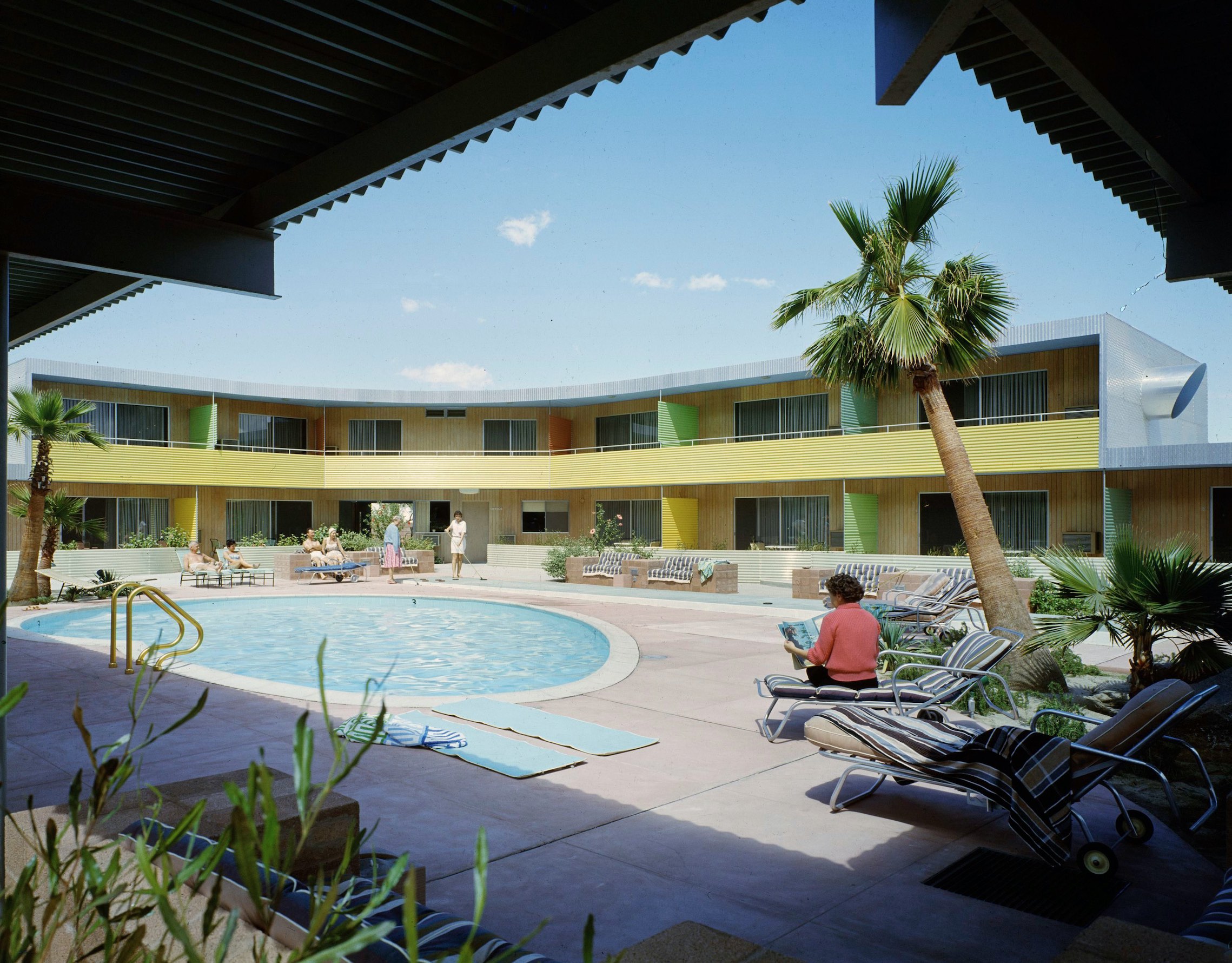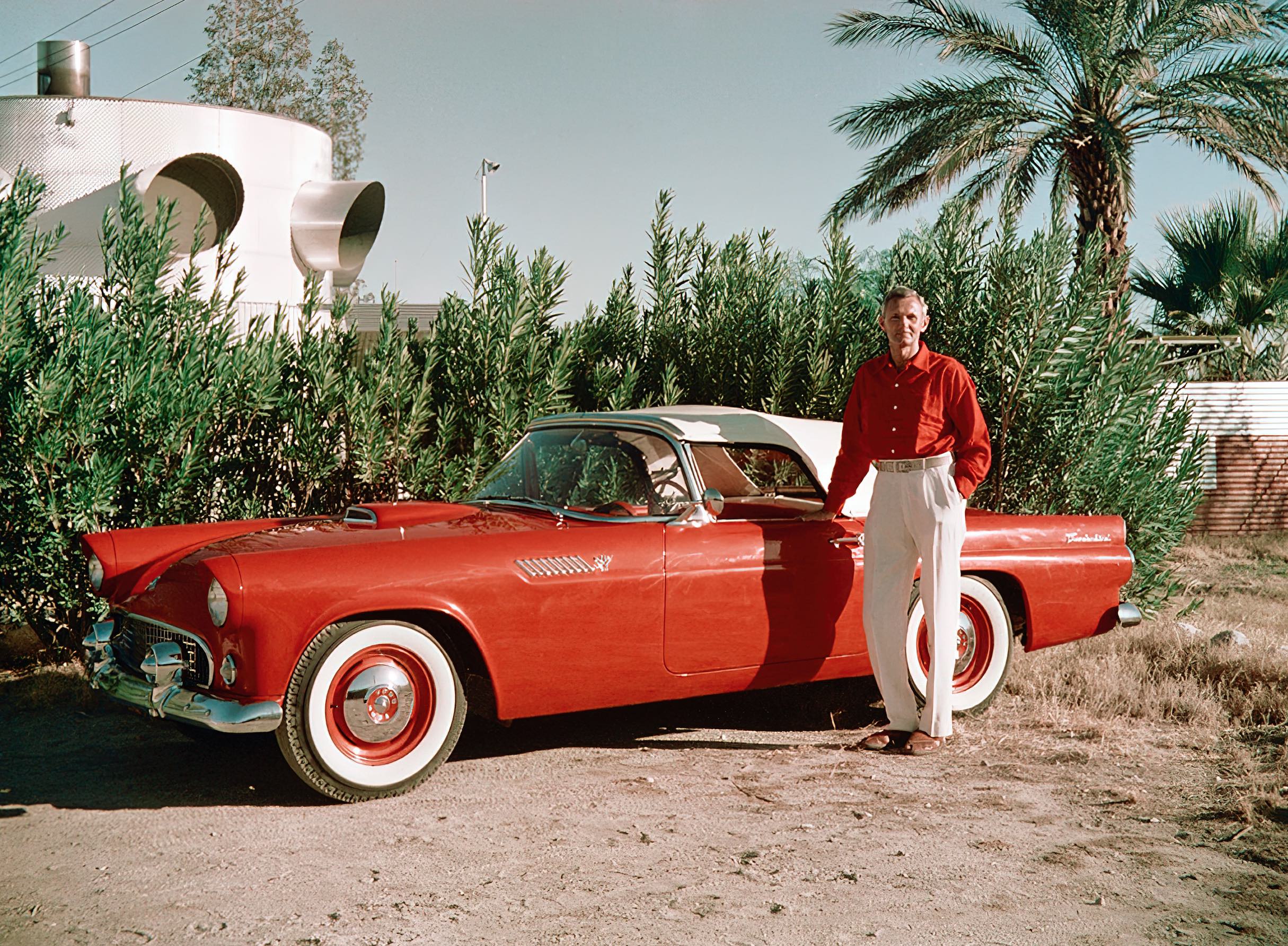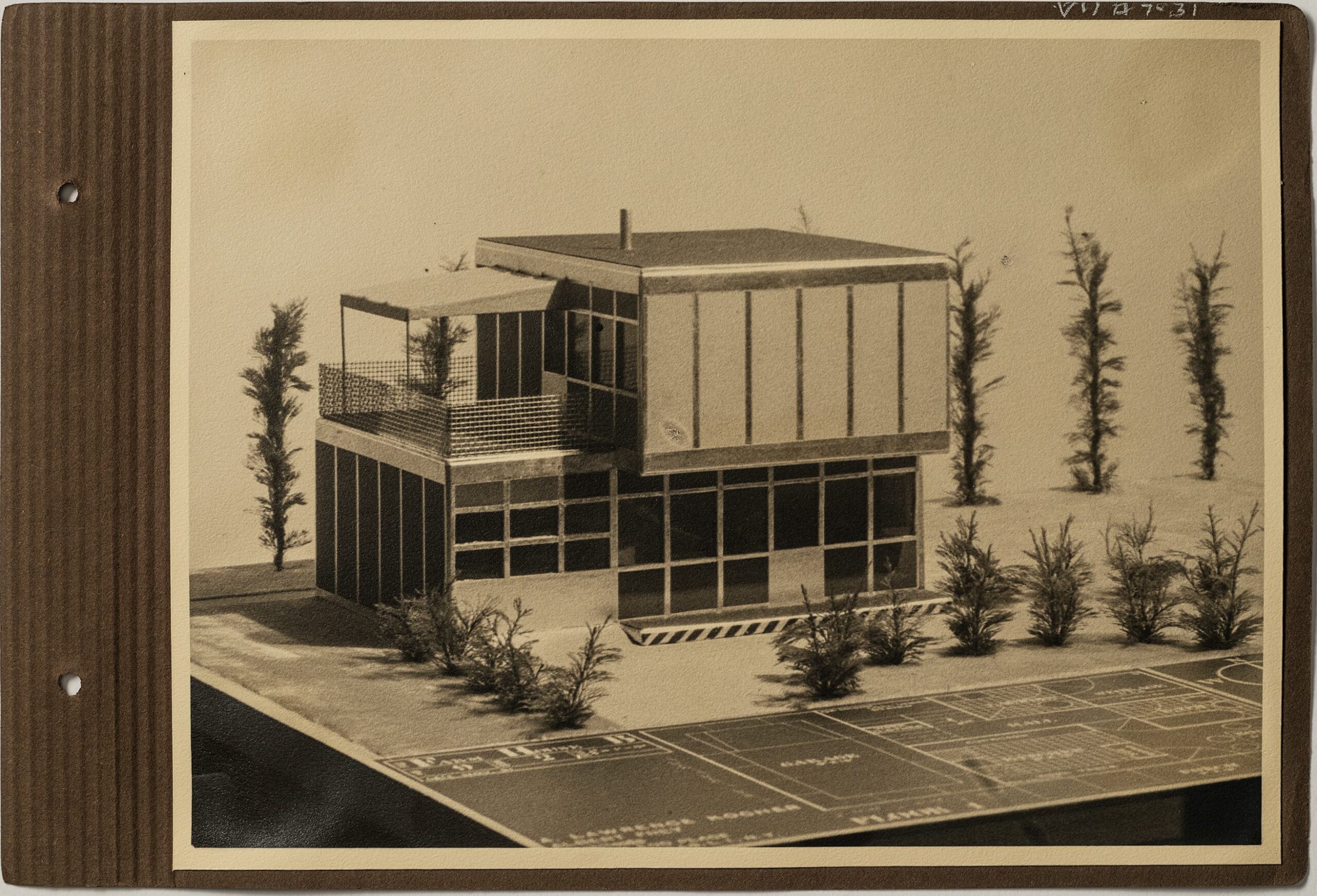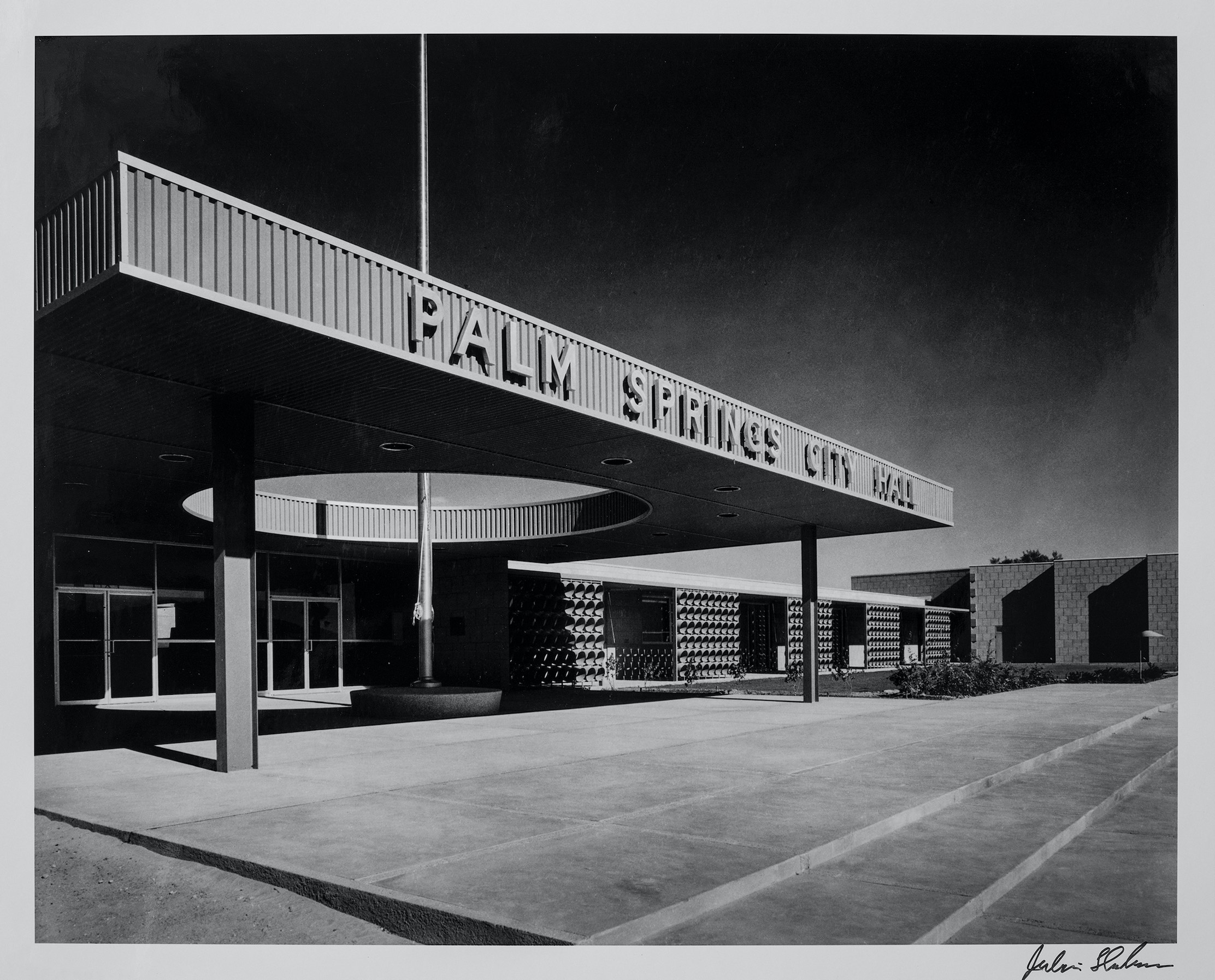The Swiss architect from the studio of Le Corbusier who went on to create his own brand of modernism in the Californian desert is being celebrated in Palm Springs, the town he made his own
 Photography by Julius Shulman. Architects: Frey and Chambers. Premiere Apartments, 1958, color digital lightjet print, 20 x 25 inches. Collection of Palm Springs Art Museum, Museum purchase, 29-2007.29. © J. Paul Getty Trust. Getty Research Institute, Los Angeles (2004.R.10)
Photography by Julius Shulman. Architects: Frey and Chambers. Premiere Apartments, 1958, color digital lightjet print, 20 x 25 inches. Collection of Palm Springs Art Museum, Museum purchase, 29-2007.29. © J. Paul Getty Trust. Getty Research Institute, Los Angeles (2004.R.10)
Words by Harriet Thorpe
There was something special about the small desert town of Palm Springs in California that appealed to Swiss architect Albert Frey. Born in Zurich in 1903, he first visited Palm Springs in 1934 and would settle there until his death in 1998. The town became an inventory of his architectural work showcasing his dynamic desert modern style – a product of his European architectural education, work experience with Le Corbusier and love of the desert landscape.
He completed over 200 projects of all scales there, from house renovations to civic and public cornerstones such as Palm Springs City Hall (1957), the Aerial Tramway Valley Station (1963) and the Tramway Gas Station, now the Palm Springs Visitor Center (1965) – each combining a mastery of industrial materials, a minimalistic economy of form and clever climate adaptation to the heat, sun and wind.
To accompany Frey’s built inventory, a new exhibition on the architect at the Palm Springs Art Museum Architecture and Design Center, Edwards Harris Pavilion, now on view, promises ‘the most comprehensive survey of his work to date’. It follows his career from Switzerland to Paris to New York then Palm Springs through drawings, plans, models, furniture, film and photography, much of it from the architect’s personal archive and previously unseen.
 Unknown photographer, Albert Frey in front of his Ford Thunderbird at Frey House I, ca. 1955, chromogenic color print, 3 1⁄2 x 5 inches. Collection of Palm Springs Art Museum. Jean Farrar Collection, S2020.1
Unknown photographer, Albert Frey in front of his Ford Thunderbird at Frey House I, ca. 1955, chromogenic color print, 3 1⁄2 x 5 inches. Collection of Palm Springs Art Museum. Jean Farrar Collection, S2020.1
Architectural models are a key tool for storytelling: there’s a 1930s model of the original Museum of Modern Art in New York (1939), which Frey worked on under Philip Goodwin and Edward Durell Stone, and a series of newly commissioned large-scale models that include two now-demolished buildings, the Weekend Canvas House in New York (1933) and the Frey House I (1940), his first home in Palm Springs where he lived for 25 years.
As well as stepping back in time, visitors can also simply step outside to experience the work of Frey. The exhibition heralds the new, permanent arrival of the Aluminaire House (1931) to Palm Springs. Frey’s first US project, the futuristic metal and glass house was designed by Frey and American architect A. Lawrence Kocher as an experimental, low cost model for modern housing, to be prefabricated and constructed in under 10 days. Included in the Museum of Modern Art’s Modern Architecture: International Exhibition of 1932, it is one of the first examples of a hybrid of European and American modernism.
That is what makes Frey so important to architectural history, explains Brad Dunning, curator and designer of the exhibition. He describes Frey as an ‘emissary’ of Le Corbusier to the US – one that just so happened to land in Palm Springs and spark its evolution into the mecca of desert modernism that it is today. After studying architecture in Winterthur, Switzerland, during the height of movements such as De Stijl and Bauhaus, Frey worked on buildings in Belgium and then joined the Paris office of Le Corbusier and Pierre Jeanneret in 1928, notably working on Villa Savoye (1931). When he immigrated to New York in 1930, he brought all of this European influence with him.
 Unknown photographer. Architects: Kocher & Frey. Model of Farmhouse B. 1932, gelatin silver print, dimensions. Collection of Palm Springs Art Museum. Albert Frey Collection, 55-1999.2. Photo by Lance Gerber
Unknown photographer. Architects: Kocher & Frey. Model of Farmhouse B. 1932, gelatin silver print, dimensions. Collection of Palm Springs Art Museum. Albert Frey Collection, 55-1999.2. Photo by Lance Gerber
The project that took him from New York to Palm Springs was another collaboration with Kocher, the Kocher-Samson Building (1934), an office and apartment building, considered the first modernist building in Palm Springs – it still stands today, though has gone under multiple renovations, and is now home to a vintage store and holiday apartment. Though, to experience Frey at his most well-preserved peak, visitors to the exhibition must also see the Frey House II (1964), which is part of the Palm Springs Art Museum collection and represents his later, most sophisticated work.
The minimalist house sits on a concrete base slotted into the San Jacinto mountain overlooking the town. It has a steel structure, corrugated metal roof with deep overhangs and walls of glazing opening up views over the Coachella Valley – all balanced by a solid, boat-like interior of built-in timber furniture, exposed rock, blue surfaces and yellow curtains.
Dunning calls the house Frey’s ‘masterpiece’, comparing it to a Donald Judd sculpture, where interior and architectural elements work in tightly conceived yet experimental symbiosis with land and light. These were the qualities exploited by photographer Julius Shulman, who captured Frey’s work in striking black and white images that can be seen in the exhibition; yet Dunning also wanted to immerse visitors in Frey’s signature colours too, which can be seen on the gallery walls, painted in dusty pastels, pinks and greens.
 Photography by Julius Shulman. Architects: Clark, Frey, and Chambers. Palm Springs City Hall, 1958, black and white digital lightjet print, 12 x 14 15/16 inches. Collection of Palm Springs Art Museum, Museum purchase, 29-2007.35. © J. Paul Getty Trust. Getty Research Institute, Los Angeles (2004.R.10)
Photography by Julius Shulman. Architects: Clark, Frey, and Chambers. Palm Springs City Hall, 1958, black and white digital lightjet print, 12 x 14 15/16 inches. Collection of Palm Springs Art Museum, Museum purchase, 29-2007.35. © J. Paul Getty Trust. Getty Research Institute, Los Angeles (2004.R.10)
‘The exhibition design captures Frey’s masterly embrace of colours that worked in the desert; I don’t think people understand how sensitive the desert is to colour – the sunrise and sunset, the blooming desert flowers,’ he says. For an even fuller immersion, there is an abounding accompanying catalogue published by Radius Books and a Frey-themed symposium and architectural tours running during Palm Springs Modernism Week (15-25 February 2024).
Albert Frey: Inventive Modernist, January 13 – June 3 2024 at the Palm Springs Art Museum Architecture and Design Center, Edwards Harris Pavilion psmuseum.org
Get a curated collection of design and architecture news in your inbox by signing up to our ICON Weekly newsletter
















